Complete Solutions to QUESTION BANK of chapter CLASSIFICATION TO ELEMENTS AND PERIODICITY IN PROPERTIES of Class 11 book with complete answers and questions
| Class 11 | CHEMISTRY |
| Chapter | CLASSIFICATION TO ELEMENTS AND PERIODICITY IN PROPERTIES |
| A N EXCEL PUBLICATION | QUESTION BANK |
| Number Of Questions | 88 |
| Academic Year | 2023-24 |
What would be the IUPAC name and symbol for the element with atomic number 120 ?
View SolutionHow would you justify the presence of 18 elements in the `5th` period of the Preodic Table ?
View SolutionThe elements Z = 117 and 120 have not yet been discovered. In which family/group would you place these elements and also give the electronic configuration in cach case.
View SolutionWhich of the following species will have the largest and the smallest size ? `Mg, Mg^(2+),Al, Al^(3+)`.
View SolutionWhich of the following will have the most negative electron gain enthalpy and which the least negative ?
P,S,Cl,F. Explain your answer.
View SolutionUsing the periodic Table, predict the farmulas of compounds which might be formed by the following pairs of elements,
Silicon and bromine.
View SolutionUsing the periodic Table, predict the formulas of compounds which might be formed by the following pair of elements, aluminium and sulphur.
View SolutionAre the oxidation state and covelency of Al in `[AlCl (H_2O)_5]^(2+)` same ?
View SolutionOn the basis of quantum numbers justify that the sixth period table should have 32 elements.
View SolutionIn terms of period and groups where would you locate the element with Z = 114 ?
View SolutionWrite the atomic number of the element in the third period and group 17 of the period table.
View SolutionWhich element do you think would have been named by
Lawrence Berkeley laboratory.
View SolutionWhich element do you think would have been named by
Seaborg's group.
View SolutionWhy do elements in the same group have similar properties ?
View SolutionWhat do you mean by isoelectronic species ?
View SolutionName the species that will be isoelectronic with Ar
View SolutionName the species that will be isoelectronic with `Mg^(2+)`
View SolutionName the species that will be isoelectronic with `Rb^+`
View Solution`N^(3-),O^(2-),F^-,Na^+, Mg^(2+),Al^(3+)` what is comman in them ?
View Solution`N^(3-),O^(2-),F^-,Na^+, Mg^(2+),Al^(3+)` Arrange them in the order of increasing ionic radii.
View SolutionEnergy of an electron in the ground state of hydrogen atom is `-2.18 xx 10^(-18) J`. Calculate the inoisation enethalpy of atomic hydrogen in `J mol^(-1)`.
View SolutionAmong the second period elements the actual ionisation enthaply are in the order `Li lt B ltBe lt C lt O ltN lt F lt Ne.
`Expalin why Be has higher `Delta IH` than B.
View SolutionAmong the second period elements the actual ionisation enthaply are in the order `Li lt B ltBe lt C lt O ltN lt F lt Ne`explain why O has lower `Delta IH` than N and F ?
View SolutionHow would you explain that the first ionisation energy of Na is lawer than that of Mg but is second inoisation enthalpy is higher than that of Mg ?
View SolutionWhat are the main factors due to which the ionisation enthalpy of the main group elements tends to decrease down a group ?
View SolutionThe first IE `(Kj mol^(-1))`of group 13 elements are
`B/801 Al/577 Ga/579 In/558 Tl/589`
How would you explain the deviation from general trend ?
View SolutionWhich of the following pairs would have more negative electron gain enthalpy ? O or F
View SolutionWhich of the following pairs would have more negative electron gain enthalpy ? F or Cl
View SolutionWould you expect the second electron gain enthalpy O as positive, more negative or less negative than the first ? Justify your answer.
View SolutionDiscribe the theory associated with the radius of an atom as it gains an electron
View SolutionDiscribe the theory associated with the radius of an atom as it loses an electron
View SolutionWould you expect the first IE of two isotopes of the same elements to be the same or different ? Justify the answer.
View SolutionWhat are the mojor differece between metals and non metals ?
View SolutionThe inceasing order of reactivity among group 1 elements is `Li lt Na lt K lt Rb lt CS` whereas that among group 17 is `F gt Cl gt Br gt I`. Explain .
View SolutionAssing the position of the elements with outer electronic configuration `ns^2np_4 (n = 3)`
View SolutionAssing the position of the elements with outer electronic configuration `(n-1) d^2 ns^2(n = 4)`
View SolutionAssing the position of the elements with outer electronic configuration `(n-2)f7 (n-1)d^1 ns^2 (n=6)`
View SolutionThe first IE and second IE `(Kj mol^(-1))` and `dalta_egH(kJ mol^(-1))` of a few elements are given below:
 Which of the above is likely to be the least reactive element
Which of the above is likely to be the least reactive element
View SolutionThe first IE and second IE `(Kj mol^(-1))` and `dalta_egH(kJ mol^(-1))` of a few elements are given below:
 Which of the above is likely to be the most reactive element
Which of the above is likely to be the most reactive element
View SolutionThe first IE and second IE `(Kj mol^(-1))` and `dalta_egH(kJ mol^(-1))` of a few elements are given below:
 Which of the above is likely to be the most reactive non- metal
Which of the above is likely to be the most reactive non- metal
View SolutionThe first IE and second IE `(Kj mol^(-1))` and `dalta_egH(kJ mol^(-1))` of a few elements are given below:
 Which of the above is likely to be the least reactive non-metal
Which of the above is likely to be the least reactive non-metal
View SolutionThe first IE and second IE `(Kj mol^(-1))` and `dalta_egH(kJ mol^(-1))` of a few elements are given below:
 Which of the above is likely to be the metal that can from stable binary halide`(MX_2)`
Which of the above is likely to be the metal that can from stable binary halide`(MX_2)`
View SolutionThe first IE and second IE `(Kj mol^(-1))` and `dalta_egH(kJ mol^(-1))` of a few elements are given below:
 Which of the above is likely to be the metal that can from perdominantly stable covalent halide (MX) ?
Which of the above is likely to be the metal that can from perdominantly stable covalent halide (MX) ?
View SolutionPredict the formulae of stable binary compounds that would be the formed by the combination of following pairs of elements. Li and `O
View SolutionPredict the formulae of stable binary compounds that would be the formed by the combination of following pairs of elements. Mg and `N
View SolutionPredict the formulae of stable binary compounds that would be the formed by the combination of following pairs of elements. Al and `I
View SolutionPredict the formulae of stable binary compounds that would be the formed by the combination of following pairs of elements. Si and `O
View SolutionPredict the formulae of stable binary compounds that would be the formed by the combination of following pairs of elements. P and `F
View SolutionPredict the formulae of stable binary compounds that would be the formed by the combination of following pairs of elements. Elements 71 and `F
View SolutionIn the modern periodic table, the period indicates the value of
View SolutionThe size of iso electronic species `F-Ne` and `Na^+` is affected by
View SolutionConsidering the elements B,Al,Mg and K, the correct order of their metallic charcter is
View Solutionconsidering the elements F,Cl, O and N, the correct order their chemical reactivity in terms of oxidising property is
View SolutionAccount for the following: Ionisation enthalphy of nitrogen is greater than that of oxygen
View SolutionAccount for the following: Atomic radius decreases from left to right in a period
View SolutionAccount for the following: Electronic gain enthalphy of F is less negative than that of Cl
View SolutionDevelopment of priodic table have made the study of elements and their compounds easiere Discuss the main features of Mendelvee's periodic table
View SolutionDevelopment of priodic table have made the study of elements and their compounds easiere State the madern periodic law
View SolutionDevelopment of priodic table have made the study of elements and their compounds easiere Give the name of the element with otomic number 112
View SolutionA graph of aromic radius versus atomic number is given blow: What do you understand from this graph ?

View SolutionA graph of aromic radius versus atomic number is given blow: Account for the observation that cations are always smaller than the parent atom while anions are always smaller the parent atom.
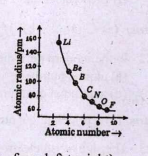
View SolutionA graph of aromic radius versus atomic number is given blow: Using the above graph, how will you account for the varitation of inoisation enthalpy in a period.
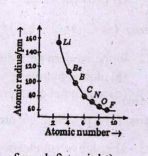
View SolutionGarph showing the variation of atomic radius with atomic number for alkali metals is given below:
Comman on the variation of atomic radius with increase in atomic number in a graph. Give reason.
View SolutionWhat is meant by isoelectronic species ?
View SolutionSelect the isoelectronic species from the following:
`O^(2-), F^-, Na^+ ,Mg^(2+)`
View SolutionState the modern periodic law
View SolutionMoseley modified Mendeleev's periodic law based on his observation on the x-ray spectra of elements.The IUPAC name of the element with atomioc number 109 is ……..
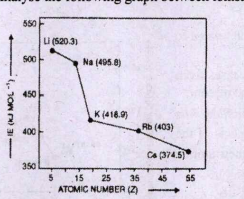
View SolutionAnalyse the following graph between ionisation enthalpy and atomic number.
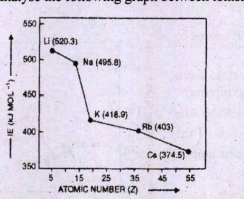
View SolutionElectron gain enthalphy is the amount of energy involved when an isolated gaseous atom accepts an electron to form a monovalent anion
the value of the electron gain enthalpy of halogens are given below:
F : `-328 KJ mol^(-1) Cl - 349 KJ mol^(-1) Br : -325 KJ mol^(-1) I : -295 KJ mol^(-1) Why the negative electron gain enthalpy decreases from chlorine iodine?
View SolutionElectron gain enthalphy is the amount of energy involved when an isolated gaseous atom accepts an electron to form a monovalent anion
the value of the electron gain enthalpy of halogens are given below:
F : `-328 KJ mol^(-1) Cl - 349 KJ mol^(-1) Br : -325 KJ mol^(-1) I : -295 KJ mol^(-1)Chlorine has more negative electron gain enthalpy than fluorine. why ?
View SolutionIdentify the largest and smallest species from those given below :
`O^(2-), F^-, Na^+ ,Mg^(2+)`
View SolutionThe reactivity of an element is very much related to its inoization enthalpy. Observe the following graph in wich the first ionozation enthalpies `(delta_1H)` of elements of the sercond period are ploptted agiains their atomic number (Z):
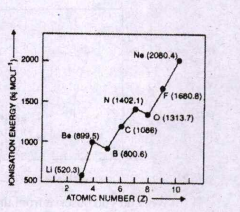
View SolutionIUPAC has made some recommendations to name elements with atomic number above 100. what would be the name for the elements with atomic number 104 ?
View SolutionElectronegativity is the ability of an atom to attract a shared pair of electrons. Name a numerical scale of electronegativity of elements
View SolutionGive the reason for the following: Phosphorus froms `PCl_5` whille nitrogen cannot from `NCl_5`
View SolutionGive the reason for the following: The first ionisation enthalpy of oxygen is smaller compared to nitrogen.
View SolutionThe first member of a group of elements in the s an dp block differs from the rest of the family in chemical behaviour. Write any one reason for this.
View SolutionWrite the general outer electronic configuration of d-block elements.
View SolutionThe first ionization enthalpy of magnesium is higher than that of sodium. Explain.
View SolutionGive any two characteristics of transition elements.
View SolutionDoes the ionisation enthalpy decreases along a group ? Give reasion
View SolutionName of elements with atomic numbers greater than 100 are given by IUPAC The atomic number of the elment with IUPAC name Ununbium is _____
View SolutionName of elements with atomic numbers greater than 100 are given by IUPAC Why is potassium considered as an s - block element ?
View SolutionName of elements with atomic numbers greater than 100 are given by IUPAC the first inoisation enthalpies of second period element generally increase from lewft to right along the period. Give reason for this general trend.
View SolutionIonization enthalpy and atomic radius are closely related properties. Analyse the following graph:
What conculation can you derive from the graph regarding the first ionization enthalpies of alkali metals and noble gases ? Justyfy.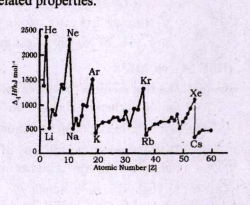
View SolutionAccounting from the following : Ionization enthalpy of Nitrogen is greater than that of Oxygen.
View SolutionAccounting from the following : 2nd period elements show anomalous behaviour
View SolutionA group of ions are given below . Find one pair which is NOT isoelectronic. `Na^(+) , Al^(3+) , O^(2-) , Ca^(2+) , Mg^(2+) , F^(-) , N^(3-) , Br^(-) `
View Solution
QUESTION BANK questions and complete solutions for chapter CLASSIFICATION TO ELEMENTS AND PERIODICITY IN PROPERTIES of A N EXCEL PUBLICATION of Class 11